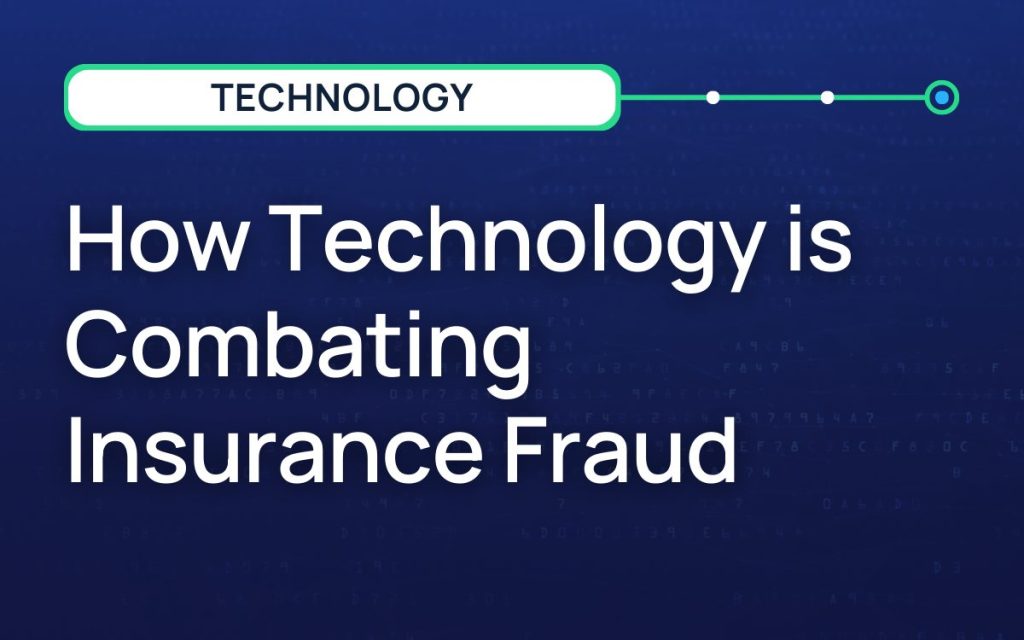How Technology is Combating Insurance Fraud

We recently wrote in great detail about the different types of insurance fraud, including how to go about committing each type (just for informational purposes, of course!). Today, our focus is on the other side of the coin: what the insurance industry is doing to prevent and detect insurance fraud, particularly by using modern technology.
A refresher on the cost of insurance fraud
Insurance fraud isn’t a victimless crime. It costs everyone from individuals and families to large businesses hundreds of billions of dollars each year. According to the National Association of Insurance Commissioners (NAIC) website:
“While fraud is constantly evolving and affects all types of insurance, the most common in terms of frequency and average cost include the following (data is from The Coalition Against Insurance Fraud and Colorado State University Global):
- Life insurance: $74.7 billion;
- Medicare: $60 billion;
- Property & casualty insurance: $45 billion; auto theft fraud totaled $7.4 billion;
- Health insurance: $36.3 billion; and
- Workers’ compensation: $34 billion ($9 billion from premium fraud; $25 billion in claims fraud).”
Source: https://content.naic.org/cipr-topics/insurance-fraud
With that much money lost each year, it’s not surprising that insurance companies have long been investing in technology to help identify fraud, or even stop it before it happens. As early as 2012, The Coalition Against Insurance Fraud began studying how the industry was using technology to combat fraud, and publishing its findings in its biennial “The State of Insurance Fraud Technology Study.”
Insurance fraud prevention technology in 2021
The most recent edition of The State of Insuracne Fraud Technology Study was published in 2021. It showed that among 80 respondents (representing “the vast majority of all major insurers operating in the United States across multiple lines of insurance”) 96 percent say they use technology to detect fraudulent claims.
This number is the largest use case, by far. But there were still significant percentages of insurers using technology for identifying and preventing fraud across other areas of the business, from underwriting to catching employees in acts of internal fraud.
As we eagerly await the release of the 2023 study, which we expect to show even greater levels of technological adoption across the industry’s top insurance carriers, we’ll elaborate on how insurers are using technology to identify and prevent fraud in the three most commonly reported categories across their business (according to the 2021 study).
1. Using technology to identify fraudulent claims
Filing an insurance claim is the point in time when a policyholder stands to gain the most from bad behavior, like overstating bodily harm or property damage, or pocketing the payment that was intended to repair or replace the insured property. It’s no surprise then that fraudulent claims are the most common type of insurance fraud. Within the category of fraudulent claims, auto claims have the distinction of having the most prevalence of fraud.
For this reason, the industry has focused its efforts on using technology to identify and prevent fraudulent claims, as demonstrated by the high percentage of insurers that report this use case compared to others.
So, how do they do it?
Predictive analytics: Insurance carriers collect a lot of data on their policyholders and claims, and have been doing so for many years. With today’s technology, they can put historical data to use and recognize patterns that indicate possible (or likely) fraud. Predictive analytics includes machine learning algorithms and statistical modeling, meaning technology can comb through millions of pieces of data and flag only the instances that are likely to include fraud. Flagged claims may include both claims that meet recognized patterns based on past (confirmed) fraud, and claims with unusual activity, patterns, or outliers that haven’t been seen before and need to be reviewed by an expert. By flagging potentially fraudulent claims, carriers dedicate human attention only to the reviews that need it.
Social network and behavior analysis: Actions speak louder than words, right? In today’s world, where almost everything you do leaves an electronic footprint, insurers can use technology to identify patterns of behavior that don’t line up with a claim. The most obvious example is someone who’s claimed severe injury in a car accident and is seeking compensation for medical expenses and lost wages, but then goes on an expensive vacation and posts pictures of themselves scuba diving and surfing. The person with injuries that prevent them from working is suddenly physically fit to do all sorts of things (and Tweets about it!). Whereas in the past, uncovering this type of fraud relied on expensive private investigators, modern technology allows insurers to scan social media and other publicly available data sources to flag cases where reality doesn’t line up with a claim.
2. Using technology to identify fraudulent applications and underwriting fraud
The entire business of insurance is based on the premise that insurance carriers can accurately assess risk and price policies accordingly. Generally, people with higher risk pay higher premiums, while pooling the risks of large populations also keeps any one person from needing to carry an excessive burden. These calculations happen in the underwriting process and rely heavily on an insurance applicant providing honest information. A 40-year-old nonsmoking female will pay less for life insurance than a 60-year-old male smoker, based on actuarial data that determines exactly how much more risk each variable brings along with it.
But the entire system fails if applicants provide false information on their insurance applications. Doing so to obtain better rates, or to get insurance when someone likely wouldn’t qualify at all, is a type of insurance fraud.
How are insurance carriers using technology to identify and prevent it? In addition to predictive analytics and social network analysis as mentioned above, one emerging technology is based on a consumer’s behavior while completing an insurance application.
Identifying application “gaming”: Imagine you’re trying to get a car insurance quote online. You put in all your information, including the names and ages of all drivers, where the vehicle will be stored, and how many miles it’s driven each year. Then, the instant quote comes back and it’s way too high! So, you start making adjustments: Remove a younger driver; change the ZIP code where you’ll store the car; reduce the annual miles. You keep making tweaks and refreshing the quote to see how your premium changes each time. This type of premium evasion may have worked in the past, but modern technology is making it less likely to succeed. Thanks to artificial intelligence and machine learning, insurers can spot the kinds of behavior patterns that show someone may be trying to game the application. This is just one example, but across all types of insurance products, technology is keeping an eye out for indications that someone’s adjusting application data to achieve a specific (and favorable) underwriting decision.
3. Using technology to sniff out internal insurance fraud
Insurance policyholders aren’t the only ones capable of defrauding an insurance carrier. Internal fraud, which means cases perpetrated by someone on the inside (i.e. insurance agents, insurance carrier employees, or insurance industry executives – among others) are also a serious and costly problem.
Some examples of internal insurance fraud include:
- An insurance agent who sells a consumer a fake policy and pockets the premium
- An insurance producer who conducts business without a valid license, or with a license obtained by providing false information
- Anyone who falsifies information to a policyholder in an attempt to get them to cancel one policy and buy another (usually more expensive) policy that’s not in the consumer’s best interest
If you think AI, machine learning, predictive analytics, and behavior analysis help stop this kind of fraud, too, you’d be correct. In addition, insurance agencies and carriers may take advantage of:
Text mining: An insurance agent, broker or insurance carrier employee creates a lot of unstructured data in the course of their daily job. Things like emails, video calls, notes on their desktop, or even sticky notes on their literal desktop. While technology may not be able to sweep the contents of handwritten post-its, it can look at just about everything else. Text mining, and similar practices like opinion mining/sentiment analysis, use AI to comb through massive amounts of what might seem like “meaningless” communication and pull out themes and patterns that can indicate fraud.
The future of insurance fraud prevention
Insurance fraud detection and prevention is growing increasingly more high-tech, but still relies largely on manual effort. According to the 2021 State of Insurance Fraud Technology Study, 39 percent of respondents said that “more than 30 percent” of the cases flagged as fraud came from an automated system, with the remaining attributed entirely to human review. While this is up from the 2018 data, that still leaves a majority of insurers relying on human fraud detection for the bulk of their cases. And it might not be because they don’t want to use technology, or believe that using it would be beneficial. Insurers cite their lack of IT resources and the challenge of getting and integrating clean data as top roadblocks to using high-tech fraud prevention.
Criminals never rest, so the industry has to work hard to stay one step ahead. Currently, the NAIC’s Antifraud Technology (D) Working Group is busy preparing to come to the table with some proposed solutions at the NAIC’s annual Fall National Meeting. As a subset of the larger NAIC Antifraud (D) Task Force, the Technolgoy Working Group is specifically aiming to create a digital repository of antifraud plans, and propose ways for regulators, fraud investigators, law enforcement, insurance carriers, and others to better share information to help the common cause.
Speaking of connecting the industry from carriers to agencies and everyone in between… If you’re looking for a faster, easier, more secure way to manage the entire producer lifecycle – including up-to-date information about who’s compliant (or not) in every state and jurisdiction, check out AgentSync.

